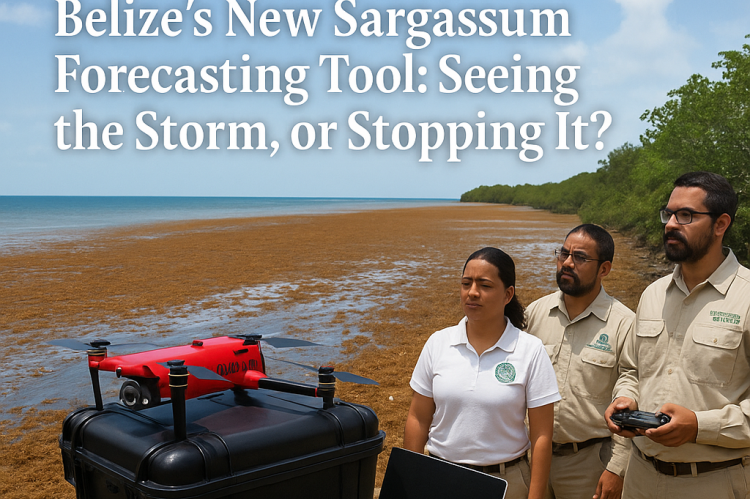📰 Belize’s New Sargassum Forecasting Tool: Seeing the Storm, or Stopping It?
By: Omar Silva, Editor–Publisher
National Perspective Belize – Digital 2025 Edition
Belize City: Sunday
A Tool in Hand, a Question in the Air
Belize’s Department of the Environment has unveiled its latest environmental weapon: a Sargassum Forecasting Tool worth US $190,000, funded under the SICA AZUL project with support from Taiwan. The package—complete with drone, laptop, and modeling software—will now anchor the work of the National Sargassum Task Force (NSTF), which brings together the Meteorological Service, DOE, the Ministries of Tourism and Blue Economy, and other agencies.
Officials hailed the tool as a “cutting-edge digital platform” capable of predicting where and when the brown seaweed will reach Belize’s coast. Chief Meteorologist Ronald Gordon explained, “It uses satellite imagery and ocean-current models to detect and forecast the motion of sargassum, so we can give residents more precise warnings.”
But behind the optimism lies an uncomfortable question: Can Belize now only see the storm coming, or can it actually stop it?
The Eye of the Task Force
Since 2018, Belize has maintained a multi-agency Sargassum Task Force to coordinate response efforts. Its remit covers collection, containment, disposal, and public awareness, and it has guided municipalities and resorts through seasons of thick, rotting mats that have crippled tourism and fishing livelihoods.
In July 2025, Cabinet approved an Emergency Response Plan after a surge estimated at 70 percent above 2022 levels. The plan promised funding, cleanup assistance, and an early-warning system—the very niche the new forecasting tool now fills. Yet, the Task Force remains a coordinating body without its own statutory budget, relying on Cabinet goodwill and donor grants. That leaves much of the operational response in limbo.
Forecasting Meets the Reality of the Beach
The forecasting model covers the entire Belizean coastline, allowing technicians to visualize sargassum movement from north to south, with size and timing estimates. In theory, that precision should let coastal communities pre-position crews, barriers, and skimmers.
In practice, many coastal councils are already spending tens of thousands of dollars weekly on cleanup, while national relief grants barely cover fuel and labor. San Pedro alone reports expenditures near BZ$45,000 per week, even after small assistance tranches from the Belize Fund for a Sustainable Future and the Tourism Board.
A few pilot projects—booms and harvesters offshore Ambergris Caye, limited composting trials in the south—hint at solutions. Yet they remain isolated, short-funded experiments. The forecasting tool may now predict where the next mats will strike, but the machinery to intercept or repurpose them is still embryonic.
A Strategy Half-Built
Environmental officers describe Belize as “ahead of the region” on sargassum management. In truth, the country has stronger eyes but weaker arms. Missing pieces include:
- Binding trigger protocols—no national standard that links forecast severity to automatic deployment of cleanup funds or equipment.
- Offshore interception infrastructure—barriers, skimmers, and barges still at pilot scale.
- Certified disposal sites—few mapped, monitored, or regulated under an environmental code.
- Public data access—no open online dashboard for municipalities, fishers, and resorts.
- Stable financing—seasonal emergency grants instead of a dedicated annual budget line.
Without these, forecasting can only warn; it cannot defend.
From Brown Tide to Blue Economy
Belize’s coastline fuels the very industries—tourism, fisheries, and real estate—that keep its economy afloat. Repeated inundations erode beaches, smother seagrass, and corrode brand reputation. Neighboring Mexico has built fleets of offshore harvesters; Jamaica and the Dominican Republic have piloted sargassum-to-fertilizer industries. Belize, blessed with foresight and software, now needs political will and public investment to turn data into defense.
The Road Ahead
For the forecasting tool to deliver more than dashboards and press photos, the Government must:
- Enact a National Sargassum Management Act with budgeted response triggers.
- Institutionalize interception capacity—booms, harvesters, and transport barges linked directly to forecast alerts.
- Designate and regulate disposal sites under DOE standards aligned with the CRFM Model Protocol.
- Publish real-time forecasts online, so communities can act, not wait for circulars.
- Invest in valorisation research—turning collected biomass into compost, blocks, or biofuel.
- Lead regionally within SICA and CARICOM to push for upstream nutrient-runoff controls and climate funding.
Until these steps are locked in, the new forecasting tool will remain just that—a screen predicting the next wave of a crisis we already know too well.
- Log in to post comments

